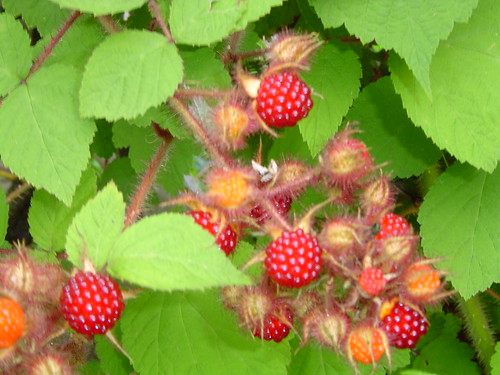
I started keeping a journal in third grade, when someone gave me a little blue journal with a brass lock. I didn't start a nature journal until much more recently. But I wish I'd started earlier.
There's no right way to keep a nature journal. But it is a very good thing to keep one. What type you keep depends on your personality and interests. Try a few approaches and see which works for you.
The "five year" journal. In a pre-printed 5-year diary (
like these
these
), there is typically one page for each day of the year; each is divided into five sections. You have just a few lines to write down your observations for each day. My grandmother recently received in the mail several five-year journals kept by my great-great-uncle in the early 1900's, and they were fascinating: fiddle gigs, cow mating, losing a finger in a sawmill, that kind of thing. Matt and I were inspired to start our own, focusing on nature observation. We use looseleaf paper in a 3-ring binder, and instead of having 1 page per day, we've collapsed it into 5-day windows (observations for January 1-5 are mixed together on one page). We're just now getting to the place where we started it last summer, and it's been very helpful in planning hikes, berry-collecting expeditions, and posts for this blog!
Longer reflections. Perhaps you'd rather have more space to reflect on your observations. It doesn't take a fancy book -- I've got a $1 composition book from CVS that I use to record my thoughts. The important thing, in my mind, is for it to be small and light enough that you can carry it with you, but big enough that you can write a coherent thought without having to turn the page. It can be rewarding to look back through a journal like this and see all you've learned, or be reminded of the wonderful things you've seen. You may want to keep a separate nature journal, or consider just journaling more about nature in a journal you already keep.
Detailed observations. You can also use journaling as a method for learning about individual plants and animals, in-depth. Carefully drawing a plant or animal is a fantastic way to force yourself to really observe. Watching the same individual over time, and noting your observations, you will learn even more. How do the flowers turn into seed pods? What does the plant look like when it first emerges in the spring?
Photography. Of course, photos can be another tool for recording your nature observations and making statements about what you find beautiful in nature. By taking the time to sort and label our photos (and weed them out!) every time we upload them, we've made our photography habit into another tool for remembering what to look for when. As an added bonus, set your screensaver to make a slideshow of your photos -- you'll look at them more often.
Blog. Many blogs are just online journals. We've got a sporadic one
here. Same content as other journals; it's just a different format (after all, blogs started as "web logs"). It's free to set one up on
Blogger,
Word Press, and other sites. And you can tell your mom and your friends about all the cool things you see. The drawback: it's hard to blog in the field. And the pressure to write things worthy of public consumption may keep you from just jotting things down that you otherwise might want to keep a record of. (Ours often goes months without an update.)
Kids' Journals. Just like adults, kids can use a simplified version of almost any of these methods. Take some drawing supplies on a walk, and draw something while you take a break. Or pick one favorite thing to write about when you get back. Or write down one thing you observed for each sense: the cool water, the sour wood sorrel, the chirping birds, the musty soil, the bright red flower. You can also paste in leaves and dried flowers, make bark rubbings...anything you can think of. A looseleaf binder can give a lot of flexibility for what goes into a kid's journal; or use a sketch pad with blank pages. I promise this will be a treasured keepsake, iif you use it frequently.
Life lists. Somehow keeping life lists (a list of birds or plants you have seen in the wild, over your whole life) just for the sake of generating the longest list possible seems to me to miss the experience of just enjoying whatever comes along, wherever you are. But we do make little notes in the margins of our id books about the first time we identify a species of wildflower or bird, and where we saw it. If we find ourselves identifying the same thing again, it's somehow helpful to have that note and make the association to the last time we saw it -- usually we don't have to look something up more than twice. As another point in favor of keeping a life list, just the act of writing down the name of something you've identified can help you remember it.
Do you keep a nature journal, or just dream of doing it? Have tips on journaling? Leave a comment!






































